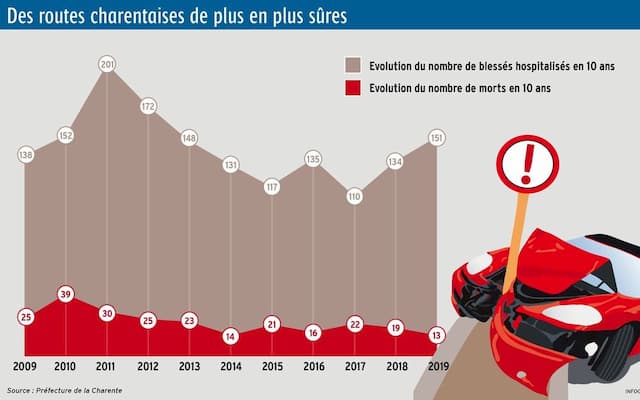Thirty-nine died in 2010. Thirteen, or three times less, this year 2019. The Charente roads have become increasingly safe over the decade. Explanations.
Thirteen killed on Charente roads in 2019. This is the lowest total ever recorded for our department. Twelve less than in 2009 and 26 less than in 2010. Since the beginning of the decade, the trend has been decreasing and the number of fatal accidents has stabilized between 15 and 20 each year. Over the same period, the national balance sheet shows a gradual decline with 4,273 killed in 2010 and 3,488 in 2018.
In the ex-Poitou-Charentes region, there has also been a decline over the past ten years, with a very poor 2018 record (119 deaths compared to 106 in 2017), due in large part to a dark year in Charente-Maritime (62 victims identified in 2018 against 40 in 2017). For 2019, the situation is contrasted in the neighbouring departments with a marked increase in the balance sheet in Deux-Sèvres (37 dead), a decrease in Charente-Maritime and Dordogne and a slight increase in Vienne.
Most of the time, dramas occur on the secondary network. According to figures from the prefecture, 14% of fatal accidents since 2012 have occurred on the national crisscrossing the Charente (21 out of 153 dead on the RN 10 and 141). Departmental roads are therefore the most deadly. And most often, it is only motorists involved who kill themselves on the roads: 9 out of 13 in 2019.
The “forgiving road”
This is why for several years, the departmental council has been developing the edges of the roadways. This is the philosophy of the “forgiving road”, praised by Didier Jobit, vice-president of the Department in charge of infrastructure. “It’s an observation. When someone goes off the road, if they hit something in the area from zero to two meters on the edge of the road, in two out of three cases, the driver dies. “ So to tackle this phenomenon, ” the idea is to remove the obstacles on the roads of first category “ . That is to say where there are the most passages. On the D 1000, the D 939 or even the D 674.
Almost 250 kilometres have already been developed in this direction. “For all new developments, we ask that they be made seven meters from the road. This is the rule, ” adds Didier Jobit. Agreements are also made with Orange, Enedis, to keep poles away or to bury them. “We also made the traffic signs fuses. They go to bed when we get inside. “
For the past three years, € 500,000 per year has been allocated by the Department to this cause. There is also the installation of rough strips when approaching dangerous turns to warn motorists.
And then in ten years, the RN 10 has been put in two double lanes from north to south. As for the RN 141, it has also been largely secured from east to west. All this, in particular, under the impetus of Senator Michel Boutant president of the Department in the early 2010s.
Road improvements, therefore, but also cars. For ten years, “vehicles absorb shock better ,” adds Thierry Benteyn, manager at the National Council of the Automotive Professions (CNPA). “Ten years ago, cars folded at the level of the head, especially on frontal impacts. Now the roof twists differently. Cars deform in ways that are more acceptable to the human body, ”he explains.
Safer cars
And to quote the Adas, these driving aids, which are “detectors of everything” . And there are vehicles “which brake alone, which alert for sleep, which remain in their trajectory, with semi-autonomous driving and adaptive cruise controls”. “We have more and more secure cars. “ Not to mention the side airbags save lives. “Afterwards, cars are not indestructible,” says Thierry Benteyn. But he points out that some manufacturers, such as Volvo, have challenged themselves to have zero deaths in their cars by 2020.
Finally, it should be noted that over the past ten years, roadside checks have also increased. There are few days when the motorcyclists of the gendarmerie and the police are not there. Sometimes with “saturation” operations : many law enforcement officers position themselves in a given sector as was the case in Rouillacais and Confolentais at the end of the year.
So, why not dream within several years of seeing zero deaths on the Charente roads?
Numbers
449. This is the number of licenses suspended due to alcohol in 2019 as of December 19. 0. No motorist was tested positive for alcohol on the evening of Christmas Eve by the gendarmes of the Angoulême company. 37,197. The number of people checked on the roads in 2018. 23. The number of speed cameras installed in Charente.




